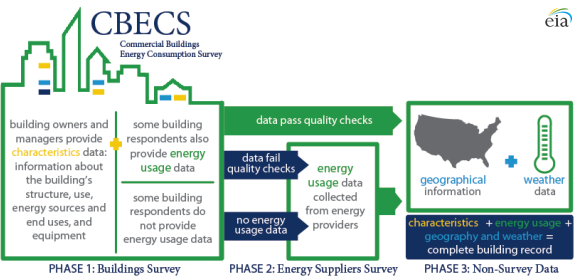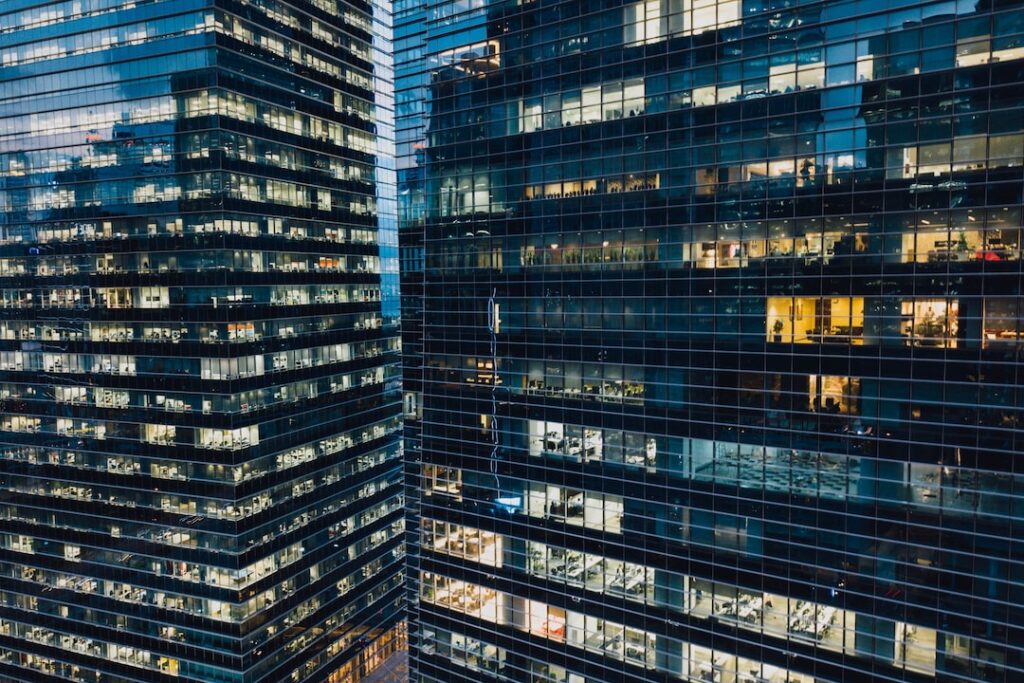A new commercial energy consumption survey sheds light on how much energy commercial buildings use and what the biggest drivers of energy consumption are.
The findings may surprise you!
Table of Contents
Key Takeaways from the 2018 Commercial Energy Consumption Survey
According to the commercial energy consumption survey, commercial buildings use an average of 40,000 BTUs (British Thermal Units) of energy per square foot.
The latest numbers from the Commercial Buildings Energy Consumption Survey (CBECS) show an increase in commercial buildings in the United States by 6% from 2012 to 2018, with 11% more total floor space.
More and more commercial buildings are investing in modern energy-saving technologies such as LED lights and EV charging ports.
The CBECS provides information for an estimated 5.9 million commercial buildings in the country. CBECS data include building characteristics such as size, age, activity, occupancy, energy consumption, and geographic region.
Here are some key takeaways from the 2018 CBECS:
- More than 2.5 million commercial buildings used LED lights, an increase of 500% from the last survey in 2012.
- More than one-third of large commercial buildings had EV charging stations.
- Most lodging and service buildings have already set up EV charging stations.
- About 30% of commercial floor space could generate electricity.
- All inpatient health care buildings used electricity generation technologies.
- An estimated 5% of buildings had smart thermostats.
What is CBECS?
CBECS is a national sample survey that collects information on U.S. commercial buildings, including their specific energy consumption.
CBECS is the only independent, statistically representative source of commercial building energy consumption data in the United States. It is conducted every four years by the U.S. Energy Information Administration (EIA).
As mentioned, one of the main limitations of CBECS data is that it doesn’t account for typical weather conditions where the building is actually located. The energy consumption of a Miami office building will be considerably different than a Chicago office building of the same size and type. This can lead to inaccurate energy consumption savings estimates.
Another essential thing to keep in mind is that the data is based on a survey of buildings, not on energy bills. This means that the data may not reflect actual energy consumption due to billing errors, inaccurate meters, and other factors.
Finally, it’s important to note that the data is self-reported by building owners and managers. This means that there is a potential for error in the data due to incorrect or incomplete information.
Despite these limitations, CBECS data is still the best source of information on commercial building energy consumption in the United States. With that in mind, it’s important to use the data wisely and to understand its limitations.
What Does the CBECS Cover?
The CBECS covers the following building types:
- Offices.
- Food service (fast food and fine dining restaurants).
- Food sales (supermarket and convenience stores).
- Lodging (hotels and motels).
- Service (dry cleaners, car washes, barber shops).
- Warehouse and storage (refrigerated and non-refrigerated).
- Education (all types of schools).
- Healthcare.
- Inpatient (hospitals).
- Outpatient (clinics).
- Public assembly (convention centers and libraries).
- Public order and safety (police and fire stations).
- Places of religious worship.
- Vacant buildings.
The CBECS surveys the following building energy data:
- Building characteristics such as the number of buildings of each property type, the amount of floor space, and structural and energy-related attributes.
- Total energy consumption data by major energy sources (electricity and fuel) and building end-use energy consumption estimates.
CBECS Energy Consumption Data
The energy end-use consumption data provide estimates of the amount of electricity, natural gas, fuel oil, and district heat used for the following categories:
- Space heating.
- Cooling.
- Ventilation.
- Domestic hot water (DHW) heating.
- Lighting.
- Cooking.
- Refrigeration.
- Computers and servers.
- Office equipment.
- Others.
A key energy performance indicator is the energy use intensity (EUI) measured in kBtu/SF.
SF refers to the building square footage inside the building, both finished and unfinished, including basements, hallways, lobbies, stairways, elevator shafts, and indoor parking facilities.
The floor area is not the same as the EPA’s Energy Star program which excludes indoor parking areas.
A building’s floor space is not equal to its total leasable or rental square footage. Many energy efficiency audit reports fail to realize this.
The CBECS provides median EUI data according to property type.
- Total building EUI.
- Electricity EUI.
- Fuel EUI (natural gas or oil).
Although the CBECS does not take into account the climate zone where the building is located, it is still a great resource for obtaining insight into how much energy different types of buildings use.

(Source)
Limitations of CBECS Data for Building Energy Consumption
When it comes to deciphering energy consumption in buildings, the Commercial Buildings Energy Consumption Survey (CBECS) is often relied upon. But there’s a devil in the details with this data that can lead to erroneous results if not understood.
For example, building end-use energy consumption data in CBECS doesn’t account for typical weather conditions where the building is actually located. This can lead to flawed energy consumption savings and therefore mistaken energy cost savings.
It’s important to have a thorough understanding of CBECS data and its limitations to avoid such mistakes. With that in mind, here’s a closer look at what CBECS is and what you need to know about interpreting the data.
Factors That Influence Commercial Energy Consumption
Many factors influence how much energy a commercial building uses. These include:
- Size of the building.
- Type of business conducted inside the building.
- The number of people who work in the building.
- The number of computers and other electronic devices that are used in the building.
- Climate control settings that are used in the building.
How Businesses Can Save Money on Energy Bills
Some common ways to reduce energy consumption and costs include:
- Improving energy efficiency in buildings and equipment.
- Using energy-efficient lighting.
- Implementing an energy management system.
- Purchasing renewable energy credits.
- Utilizing power management settings on office equipment.
Frequently Asked Questions
How much energy does the commercial sector use?
The commercial sector uses about 20 percent of the energy in the United States.
What consumes the most energy in a commercial building?
The most energy-consuming activity in a commercial building is typically operating the HVAC system.
How many kWh does a commercial building use per year?
A commercial building has an average energy use of 11,000 kWh per year.
What is CBECS?
CBECS is the Commercial Buildings Energy Consumption Survey, which is a national survey that collects information on the energy-related building characteristics and energy consumption of commercial buildings in the United States.
Conclusion
Commercial buildings account for a significant amount of energy use in the United States. Businesses should be aware of ways to save money on their energy bills.
Commercial buildings often use a great deal of energy for heating, cooling, and lighting. Many businesses are not aware of how much energy their facilities use or how to reduce their energy consumption.
The findings of the commercial energy consumption survey may help businesses to save money on their energy bills and to reduce their energy consumption.





